Rivercane Basketry | Native Practical Art Inspired By the Cherokee & Choctaw
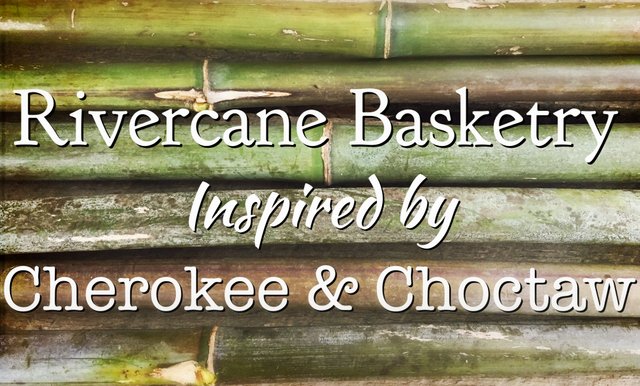
It's a new year and I'm feeling invigorated to learn a new craft. Isn't that funny how something you passed over in the past may strike an inward fancy and seemingly a breeze on the wind can propel one toward learning a new skill?
Basketmaking
It started off with hopes of purchasing some willow cuttings from Dunbar Gardens. @schoonercreek, whom some of you may remember, recommended them as a source. As more and more beautiful baskets were passing my vision on Instagram, I'd decided I would grow a patch of willow, wait for it to grow and in the meantime teach myself weaving using brambles and hopefully some wild willows that I could find near me. As I started doing research, however, I found an incredible diversity and wealth of inspiration that quickly changed my initial plans. I will likely still purchase some willow cuttings and root them in this year's Food (and useful material) Forest planting in "the Orchard" (where you've seen us recently clearing and planting apple trees.) Yet I will also be using my energy to try out other local materials, ones that have a distinct and superior history of use.
Choctaw and Cherokee
As I was racking my mind to think of different things I could gather to practice making simple baskets, I thought of the grapevines, aforementioned willows, brambles, wild roses, honeysuckle and much more. People have been weaving since before neolithic times - an art many are keeping alive and reviving and the sky is really the limit as far as what you can make baskets and other useful items with.
What I've read is that if you can bend the material at a 90 degree angle or if you can wrap it around your wrist and it doesn't break, the material is good for weaving.
I wondered, had the river cane, Arundinaria gigantea, our native bamboo (and one of the three temperate native bamboos in North America), been used?
A quick search found some jawdropping creations by this region's original inhabitants, the Choctaw and Cherokee.
Here are some samples of their works, though follow the links if you want to be further impressed. Some of these were even made to be watertight!!!
Cherokee
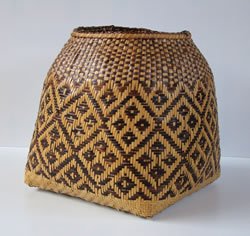
Single weave rivercane basket by
Cherokee basket maker
Lottie Queen Stamper
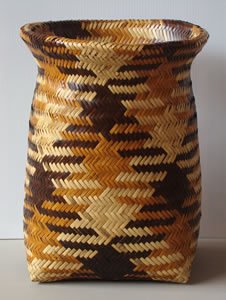
Double weave basket by Eva Woolf
Choctaw
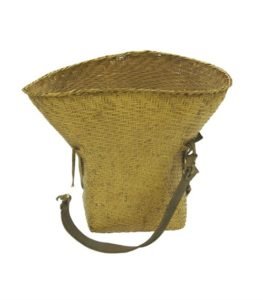
Large pack baskets, such as this one, were used by Choctaw women for transporting many types of large or bulky objects. These baskets were used to harvest fields, to collect wild food and other resources, to pack a family's belongings for travel, and even to carry the soil for constructing earth mounds. Most pack baskets, including this one, have a leather tumpline, or strap that goes over the forehead to help stabilize the load.
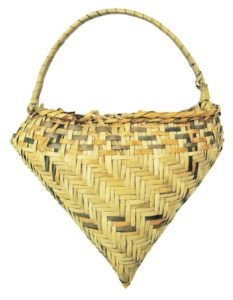
Taposhake chufa, pointed basket
Immediately, I was intrigued. This is the same river cane that we have here and I live on a creek called Caney Creek!
Ini and I have always looked at the cane and wondered what we could do with it. Our neighbors have rich stands of it and it lines the creek that abuts our land's western edge. People don't seem to value it much, though I am increasingly learning of its importance and in the importance of tending wild stands.
Cane favors stream banks and acts better than hardwood trees to stabilize the bank from erosion and to filter run-off pollutants. In fact, the big stand of cane on Highway 209 was planted as a stream bank stabilizer by the landowner, on the advice of the county agricultural extension agent, about 40 years ago.Researchers estimate that some 98 percent of the canebrakes present when the Europeans arrived have been lost. The usual suspect is the enclosure of animals, especially cattle, which eat the tender cane shoots as they emerge. In Cherokee, the tribe has sponsored a restoration project to ensure native basketmakers having a supply of cane for their work. Preserving river cane is one way to recognize the history and value of this hardy and beautiful grass. Source
It's very important that we treat this process with respect and as Robin Wall Kimmerer, author of Braiding Sweetgrass, writes,
Know the ways of the ones who take care of you, so that you may take care of them. Introduce yourself. Be accountable as the one who comes asking for life. Ask permission before taking. Abide by the answer.Give thanks for what you have been given.
Give a gift, in reciprocity for what you have taken.
To this end, I want to tend wild stands near our creek, spreading the rhizomes and making sure I am adding back what I am gratefully taking.
Foraging & Learning
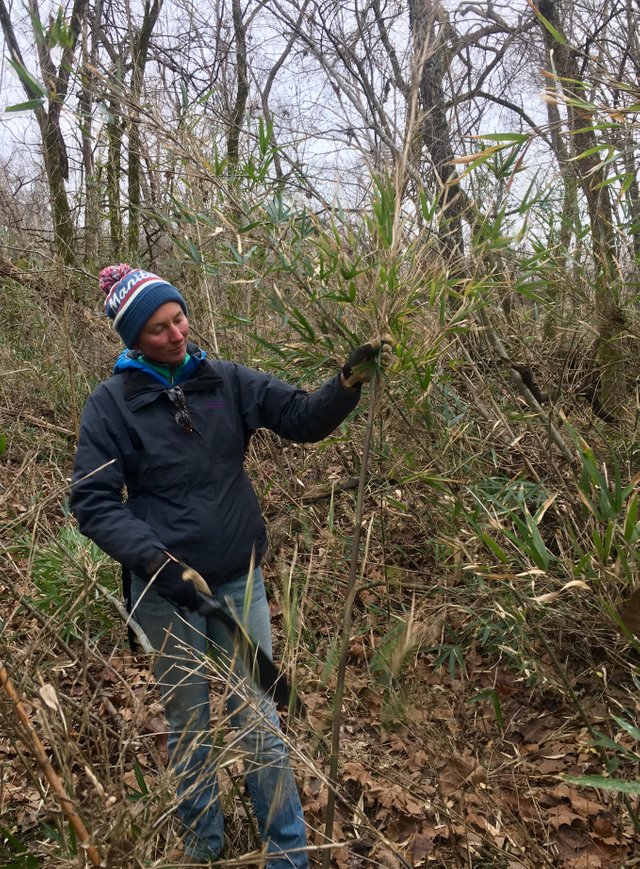
Gathering Cane and chopping the leaves off
I had done a bit of research on making basket materials from the cane, but sadly it is sorely lacking online so I wasn't sure what size or age I was looking for. I took a few big ones (the size of my thumb- which I later learned are the size you want) and some smaller ones to experiment with. I used my machete to chop off the leaves, which reside at the nodes of the cane.
That evening I brought them into the cozy cabin after googling my heart out for more information. I had found out a few things and watched 1 video which helped me understand a bit more what I was after.
Experiments
That first night was quite funny as Ini tried to split the cane in half and then into quarters and trip the inner pith out. Today I finally found a couple Youtube videos which demonstrated what needs to be done (not very high quality so I think I'll make my own once I get a better hang of it) (not very high quality so I think I'll make my own once I get a better hang of it)- not what we spent hours last night doing! Hah! But it was good practice and it's important, I think, to experiment and just try.
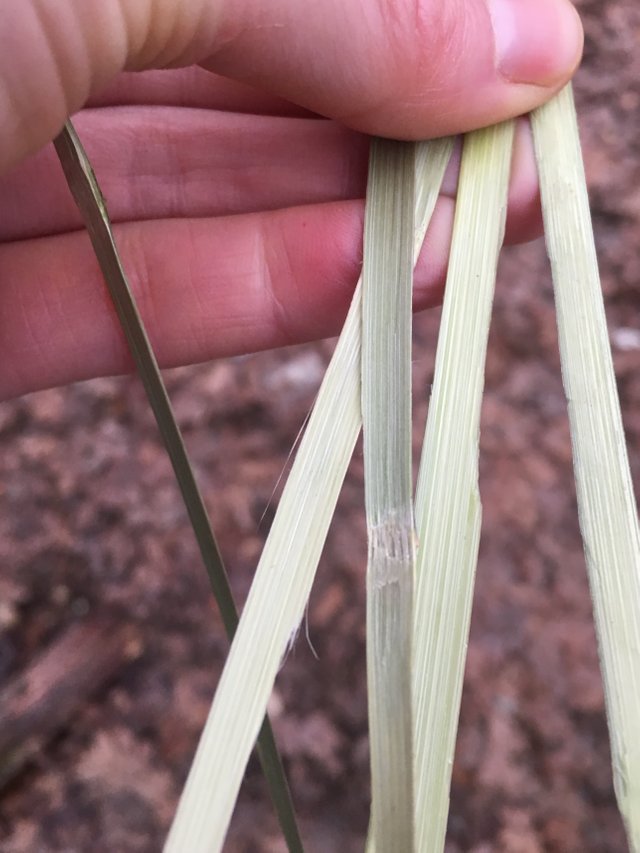
Some cane I split and took the pith off of.
This morning I went and harvested more cane and practiced using the new techniques I found out. Thank you past humans and those who have carried this tradition on! I got some usable material.
It's incredible to believe that this is just Step 1! Next, they usually would then dye the pieces, walnut and bloodroot are two popular local options, and then weave! I found some weaving demonstrations online, but I may practice using brambles as it is a lot of embedded energy in each cane piece and I would like to have a wee idea of what I'm doing before I use them.
Into the Future
I've also found some Choctaw classes in Oklahoma (about a 4 hour drive) that I may attend to learn more about these techniques. I am so thankful they've been carried on and I've watched many Youtube videos and been very heartened to discover that though not quite popular, this art has been carried on and is currently being passed to the next generations.
A fire burns inside as I study these techniques and look with wonder at the baskets and other practical items the Natives to this land created for thousands of years. I seek to honor them as I learn this craft and likely blend techniques as I gain in skill.
Exciting times! Stay Tuned!
Posted from my blog with SteemPress : http://www.ozarkmountainjewel.com/2019/01/02/rivercane-basketry-native-practical-art-inspired-by-the-cherokee-choctaw/
This is so exciting!!! I have always wanted to weave baskets but never had the time. I wonder if red beet would be a good dye for the cane pith? Truly a beautiful color right? I am going to check out our area to see if there are classes. As you know the Miccosukee Tribe is nearby in the Everglades. Keep me posted! oxox
I am so excited for you! Let me know what you find out 😍 yes beet’s a lovely color!!
Posted using Partiko iOS
Good luck on your Native quest and yes the traditions that are still being handed down through the blood lines are amazing. A real gift, I feel honored every time something is shared with me. Beautiful post of how you can create and yasit is nice Meeting you here on steemit. Happy new year to you and the fam! 🎊🎉
Thanks, dear... so so amazing and what a gift! Much love 💕
Posted using Partiko iOS
Good luck in the basket weaving adventure 🙂
I'm amazed at your progress from just googling and self learning. I once researched willow basket weaving courses here in the UK as i wanted to organise regular events/classes at festival gardens when I worked as community engagement officer.
What I learned about it was that it is a real delicate skill to learn. I think you might find quicker progression if you can make it to some classes, but I'm sure you'll get there in the end with just study and practice as well. We ended up hiring someone to teach living willow weaving because it fitted in with the conservation/countryside management course we ran.
Hope you're well and happy 2019 🙂
Posted using Partiko Android
Thanks!! Def delicate and I hope to find many mentors along the way! This stuff is downloadable but a longer path if you try to intuit it... not necessary anyway! Cool about your willow course!
Posted using Partiko iOS
Woah, cool!!! I love that pack basket, it looks super helpful. Looks like a fun and useful skill to learn :)
Yeah! So cool right?! I’m super pumped:)
Posted using Partiko iOS
Knowledge of the ancients lost to most but living still with the native Americans. Really great post.
Thanks. Yes thank Goddess they’re keeping it alive. We owe so much to them
Posted using Partiko iOS
Congratulations! This post has been upvoted from the communal account, @minnowsupport, by mountainjewel from the Minnow Support Project. It's a witness project run by aggroed, ausbitbank, teamsteem, someguy123, neoxian, followbtcnews, and netuoso. The goal is to help Steemit grow by supporting Minnows. Please find us at the Peace, Abundance, and Liberty Network (PALnet) Discord Channel. It's a completely public and open space to all members of the Steemit community who voluntarily choose to be there.
If you would like to delegate to the Minnow Support Project you can do so by clicking on the following links: 50SP, 100SP, 250SP, 500SP, 1000SP, 5000SP.
Be sure to leave at least 50SP undelegated on your account.
Thank you so much for participating the Partiko Delegation Plan Round 1! We really appreciate your support! As part of the delegation benefits, we just gave you a 3.00% upvote! Together, let’s change the world!
Hi @mountainjewel!
Your post was upvoted by @steem-ua, new Steem dApp, using UserAuthority for algorithmic post curation!
Your UA account score is currently 4.850 which ranks you at #1268 across all Steem accounts.
Your rank has not changed in the last three days.
In our last Algorithmic Curation Round, consisting of 351 contributions, your post is ranked at #47.
Evaluation of your UA score:
Feel free to join our @steem-ua Discord server
Hey @mountainjewel, my computer is breaking, so i have to fix it/buy a new one so I put you on autovote/steemauto, a 100% once a day... I also try to automate some of my posting, but if Im not responsive for a while don't worry... I'll be back!
/FF
Sounds good! Best to you!
Posted using Partiko iOS